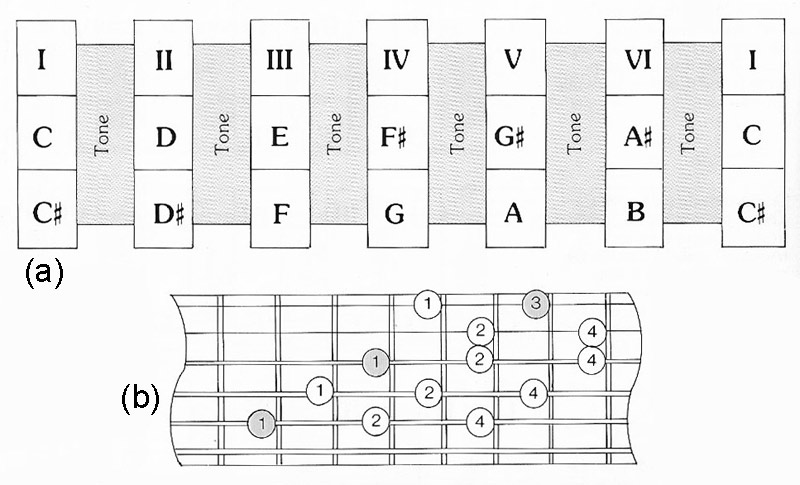symmetric scale

(a) The two whole-tone scales are symmetric scales. All 12 notes in the octave are contained in these two scales. The starting note gives the name of the scale. (b) Fingering patterns for guitar.
A symmetric scale is a musical scale that is built using a repeating pattern of intervals. Symmetric scales are used in a variety of musical styles, including classical, jazz, and contemporary music. They allow for greater flexibility and freedom in melody and harmony, and can add tension and dissonance to a musical composition. Understanding and using symmetric scales can be a valuable tool for any musician looking to expand their musical vocabulary and add depth and complexity to their compositions.
There are several types of symmetric scales, including whole-tone scales, diminished scales, and augmented scales.
The whole-tone scale is a symmetric scale that consists of six whole steps, with no half steps. This scale is made up of all whole steps, creating a sound that is very dissonant and chromatic. The whole-tone scale is not typically used as a standalone scale, but rather as a means of adding color to a melody or chord progression.
The diminished scale is a symmetric scale that consists of alternating whole steps and half steps. This scale is often used in jazz music, and it is built by starting on a root note and then ascending in a pattern of whole step, half step, whole step, half step, and so on. The diminished scale creates a sound that is very tense and dissonant, and it is often used to create tension and dissonance in a musical composition.
The augmented scale is a symmetric scale that consists of alternating half steps and whole steps. This scale is built by starting on a root note and then ascending in a pattern of half step, whole step, half step, whole step, and so on. The augmented scale creates a sound that is very dissonant and chromatic, and it is often used to create tension and dissonance in a musical composition.
In addition to these symmetric scales, there are also several other scales that are considered to be symmetrical, including the octatonic scale and the hexatonic scale.
The octatonic scale is a symmetric scale that consists of alternating whole steps and half steps, with an added half step at the end of the scale. This scale is often used in jazz music, and it is built by starting on a root note and then ascending in a pattern of whole step, half step, whole step, half step, whole step, half step, whole step, half step. The octatonic scale creates a sound that is very dissonant and chromatic, and it is often used to create tension and dissonance in a musical composition.
The hexatonic scale is a symmetric scale that consists of six notes, and it is built by starting on a root note and then ascending in a pattern of whole step, whole step, half step, whole step, whole step, half step. The hexatonic scale creates a sound that is very dissonant and chromatic, and it is often used to create tension and dissonance in a musical composition.


